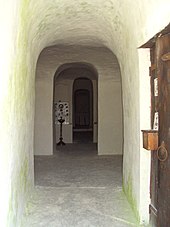Divnogorye
Coordinates: 50 ° 58 ' N , 39 ° 18' E
The Divnogorje nature reserve ( Russian Дивногорье ) is located about ten kilometers west of Liski on the edge of the Don floodplains in Voronezh Oblast . The nature reserve can be reached quickly by train from Liski. A platform is located directly on the ascent to the church and the plateau.
Geological features
Chalk deposits come to the surface in the nature reserve. The chalk plateau rises 2 mm per year from the ground. The top layer of chalk consists of approximately 20 m thick deposits with an admixture of 15 to 20% clay. Underneath there is an 80 m thick layer of pure chalk . The erosion can weather the upper chalk layer more quickly. Thus, chalk cliffs are carved out of the plateau. In heavy rain or when the snow melts, the rivers in the area turn white from the eroded chalk.
History
The remains of a rampart can be found on the northwest corner of the plateau. The Alans had a fort here to secure their northern border.
vegetation
Due to the steep slopes of the chalk plateau, the environment was exposed to very little anthropogenic changes. The chalk cliffs are a retreat for a large number of plants and animals. Steppe vegetation can be found on the plateaus. The vegetation consists of around 250 plant species from 147 groups. There are also 30 mosses and 30 lichen species from 44 families. 90% of the plants are perennial. Desert plants can be found in particularly dry areas.
In terms of plants, there are: Carex humilis , Thymus calcareus , Stipa capillata , Festuca sulcata
Church of the Sicilian Mother of God
A church was carved into the chalk cliffs of Divnogorje by Ukrainian monks around 1650. The easy-to-work chalk cliffs can already be shaped with axes and saws. There are therefore three cave churches in the Divnogorje area, and around 20 in the Voronezh Oblast.
The church impresses with its chalk-white interior walls. A cloister encompasses the chancel. To the left and right of the altar there are niches for the choir. The acoustics are overwhelming. A corridor leads from the church to some higher rooms. These rooms were used to accommodate the few monks who lived here in a monastery.
The monastery was used until 1918. In 1996 it was put back into operation. Five monks are currently teaching four convent students.
The monks coined the name Divnogorje, which means something like "wonderful mountains".
Web links
- Official site (Russian)

